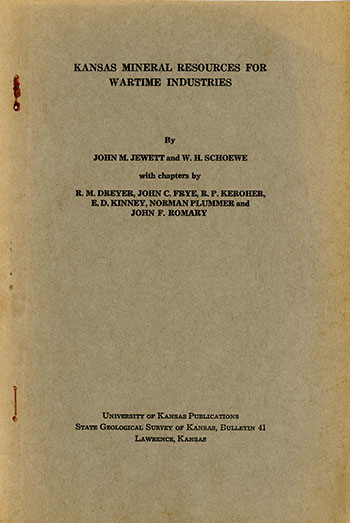Kansas Mineral Resources for Wartime Industries
by John M. Jewett and W. H. Schoewe
with chapters by R. M. Dreyer, John C. Frye, R. P. Keroher, E. D. Kinney, Norman Plummer and John F. Romary

Originally published in 1942 as Kansas Geological Survey Bulletin 41, Part 3. This is, in general, the original text as published. The information has not been updated. An Acrobat PDF version (16.7 MB) is also available.
Abstract
During the present war emergency the production and available reserves of mineral resources and other raw materials are of paramount importance to the safety of the nation. This report presents a summary of the mineral resources of Kansas, present production and known or estimated reserves, and possible uses of these resources in war industries located in Kansas. The vital relationship of fuels and metals to war industries is well known. The role of nonmetallic mineral resources in war production, although less obvious, is none the less real in both a direct and indirect way.
Fuels are essential to most industrial enterprises. The 3,700,000 tons of coal, 85,416,561 barrels of oil, and 85,632,472,000 cubic feet of gas that were produced in Kansas during 1941 are vitally important to the state and the nation in wartime, but even more important are the vast reserves of these materials and their present and potential by-products. On January 1, 1942, the estimated proved reserves of oil in Kansas were 752,670,000 barrels, which, because of new discoveries, constitute an increase over the previous year. Oil and gas produced in the state are distributed through more than 8,000 miles of pipe line and processed in Kansas at 27 refineries, 15 natural gasoline plants, and 3 carbon black plants. One helium plant not now operating has a capacity of over 8 million cubic feet annually. Coal and petroleum, particularly during wartime, should be considered not only as fuels but as basic raw materials for chemical industries. They represent important raw materials for the manufacture of such products as explosives, plastics, and synthetic rubber.
Metals are used in the manufacture of all implements of war. Aluminum and magnesium are essential to aircraft production, and although neither is now produced in the state, the vast potential reserves of each, shown in this report to occur in Kansas, assume an increasing importance as the supply in the United States of high-grade aluminum ore (bauxite) is depleted and the demand for magnesium rapidly increases. During 1941, 57,000 short tons of zinc and 12,000 short tons of lead were produced in Kansas. The Tri-State zinc and lead district, part of which is in Kansas, is the most important zinc-producing region in the world. Both zinc and lead are important in war industries.
Although non-fuel and nonmetallic mineral resources are not so spectacularly and directly related to war industries, they nevertheless constitute indispensable materials for basic industries. Asphalt rock is used as a road-surfacing material and bentonite is employed as a drilling mud, filter for oil, and a bond in foundry sand. Chalk, the Kansas reserve of which is estimated at more than 50 billion tons, is used as whiting and in the chemical industries. Ceramic products, in addition to being employed by the navy and in war industries, probably will be used to an increasing extent to replace metal products for civilian use. In 1940, Kansas produced structural clay products valued at $1,500,000; the undeveloped reserves of clay in north-central Kansas alone amount to 125 billion tons, of which 40 billion tons are light-firing clays. There is an undeveloped reserve of 1,000,000 tons of diatomaceous marl which can be used in certain types of cement and as a filtering material. The present Kansas production of Portland cement for use in construction is four and one-half million barrels annually, valued at over 5 million dollars, and the reserve of Portland cement raw materials is enormous. Kansas ranks eighth among the states as a gypsum producer. Salt is an essential material in many chemical industries, such as those producing explosives and synthetic rubber. Kansas now produces annually about 700,000 tons of salt, and the reserves in the state are estimated to be at least 5,000 billion tons. A total of 2,264,871 tons of sand and gravel, valued at $893,962, was produced in Kansas during 1940. This production could be increased many times if additional quantities were needed. Reserves of sand and gravel, rock-wool materials, and stone for construction purposes are inexhaustible. Volcanic ash is used as an abrasive, in cleaners, as a ceramic glaze, and in cement. In 1940 Kansas produced 39,215 tons, valued at $129,959, and the reserves are estimated at more than 10 million tons.
The information given in this report on mineral resources of Kansas demonstrates the wide variety of raw materials and vast reserves, in some cases almost untouched, that occur within the state. These abundant raw materials and the state's geographic position in the heart of the nation make Kansas of great strategic importance as a region for the location for war industries.
Kansas Geological Survey, Geology
Placed on web Nov. 2, 2017; originally published May 9, 1942.
Comments to webadmin@kgs.ku.edu
The URL for this page is http://www.kgs.ku.edu/Publications/Bulletins/41_3/index.html